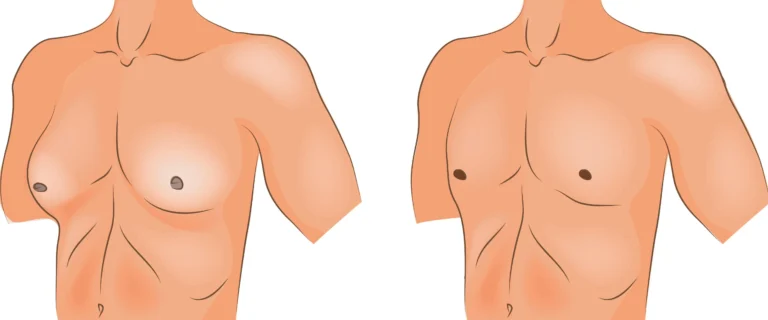As the nickname “man boobs” suggests, enlarged breasts in a male are too often dismissed or joked about. In reality, gynaecomastia is common and can feel worrying or embarrassing. This guide explains what’s going on, when to see a doctor, and which treatments help—without the stigma.
What is gynaecomastia?
Gynaecomastia is the benign enlargement of male breast gland tissue (not just fat). It usually affects both sides but can be one-sided. You may notice a rubbery or firm disc of tissue behind the nipple that can feel tender.
True vs. pseudo-gynaecomastia
- True gynaecomastia: growth of glandular tissue caused by a relative rise in the effect of oestrogen compared with testosterone.
- Pseudo-gynaecomastia (lipomastia): increased fat in the chest without gland growth—more common with overweight/obesity.
Common causes
Gynaecomastia often reflects a temporary or persistent imbalance between testosterone and oestrogen. Typical contributors include:
- Life stages: newborns (temporary maternal hormones), puberty (usually settles within 6–24 months), and older age (falling testosterone).
- Medications: cimetidine, spironolactone, some tricyclic antidepressants, certain chemotherapy/anti-androgen drugs, and hair-loss medications (e.g., finasteride/dutasteride) in rare cases.
- Substances: anabolic steroids and some supplements used for physique/strength can convert to oestrogen and trigger breast tissue growth—see our overview of performance-enhancing drugs.
- Health conditions: testicular problems (including tumours), thyroid disease, chronic liver or kidney disease, and genetic conditions (e.g., Klinefelter’s syndrome).
- Weight gain: fat tissue increases aromatase activity (conversion of androgens to oestrogens), and added chest fat can also mimic breast enlargement.
Who gets it?
- Newborn boys and girls: transient enlargement from maternal hormones.
- Adolescent boys: very common; understandably distressing but usually self-resolving.
- Men over 50: more frequent as testosterone production declines.
Could it signal something serious?
Most cases are harmless, but a medical review is important if you notice:
- a hard, fixed, or one-sided lump
- nipple discharge (especially bloody) or nipple/skin dimpling
- rapid enlargement, significant pain, or swollen glands in the armpit
- testicular lumps, loss of libido, erectile problems, or unexplained weight loss
For reliable background information, the NHS guide to gynaecomastia explains red flags and care pathways.
Getting checked: what to expect
Your clinician will review symptoms, medication/supplement use, alcohol intake, and perform a chest and testicular exam. Tests may include bloods (hormones, liver/thyroid function) and, if needed, breast or testicular imaging. Many teen cases need only reassurance and follow-up.
Treatment options
- Watchful waiting: pubertal gynaecomastia commonly settles within 6–24 months.
- Treat the cause: adjust or stop an offending medication (only with medical advice), manage thyroid/liver disease, address testicular conditions, and avoid anabolic steroids/suspect supplements.
- Medication: in persistent, painful, or very recent cases, doctors may consider selective oestrogen receptor modulators (e.g., tamoxifen). These are prescription-only and not for everyone.
- Surgery: subcutaneous mastectomy (often with liposuction) is effective for stable, bothersome tissue or for cosmetic/psychological reasons. Liposuction alone may help pseudo-gynaecomastia.
Lifestyle steps that help
- Weight management: reducing body fat can shrink chest fat and lower aromatase activity. If you’re over 40 or prefer structure, a targeted plan such as our weight-loss programme for men can help you start safely.
- Training: resistance work improves chest shape and posture (it won’t remove gland tissue but can boost confidence).
- Manage expectations: creams and “oestrogen-blocking” supplements marketed online are unproven and often a waste of money.
No cause for embarrassment
Gynaecomastia is common and usually harmless. If you’re concerned about new or persistent breast enlargement—or you notice any red-flag symptoms—book a medical review. With the right assessment and a mix of lifestyle, medical, or surgical options, most men find a solution that restores comfort and confidence.

